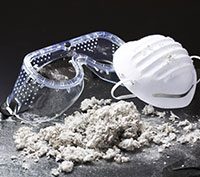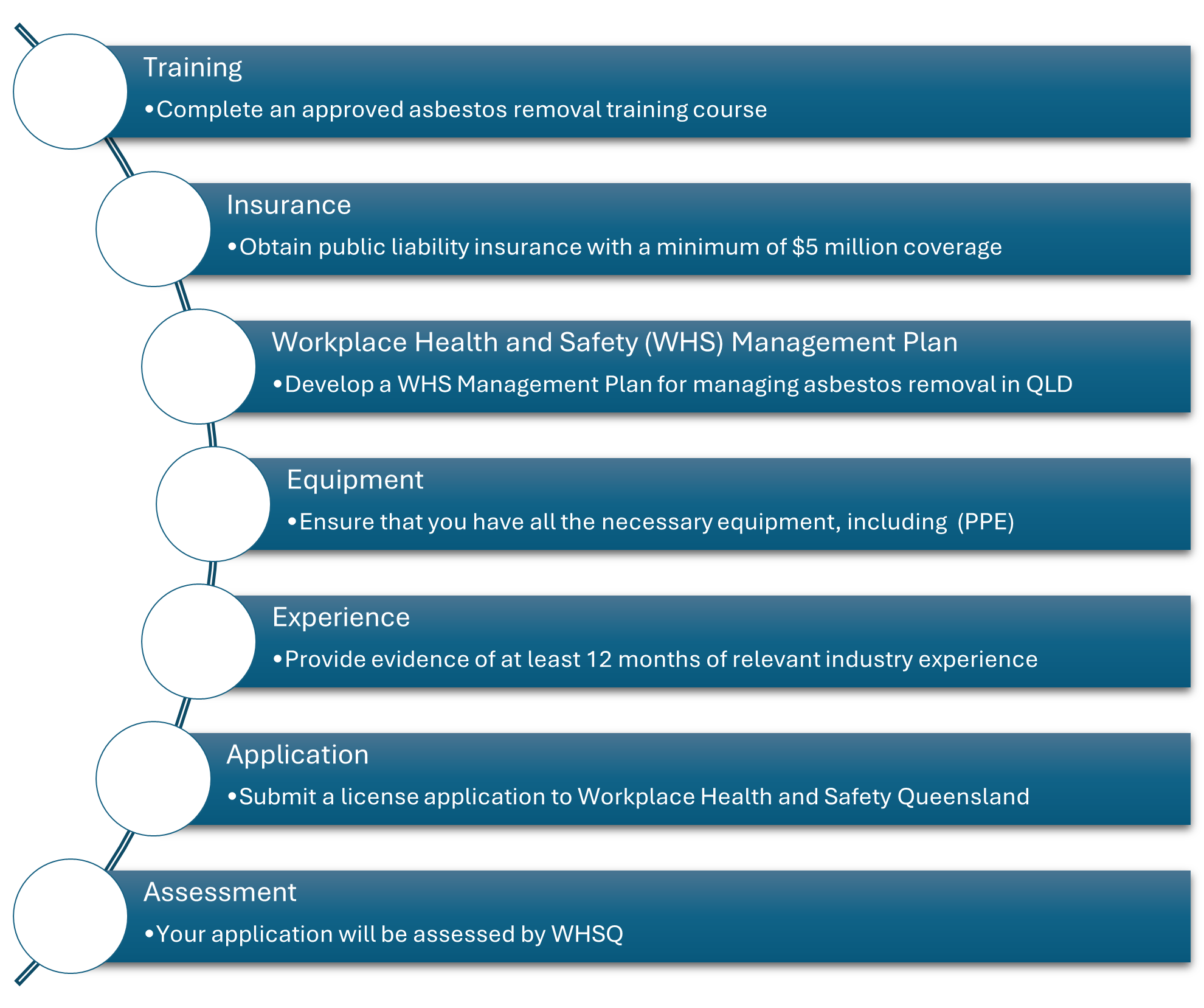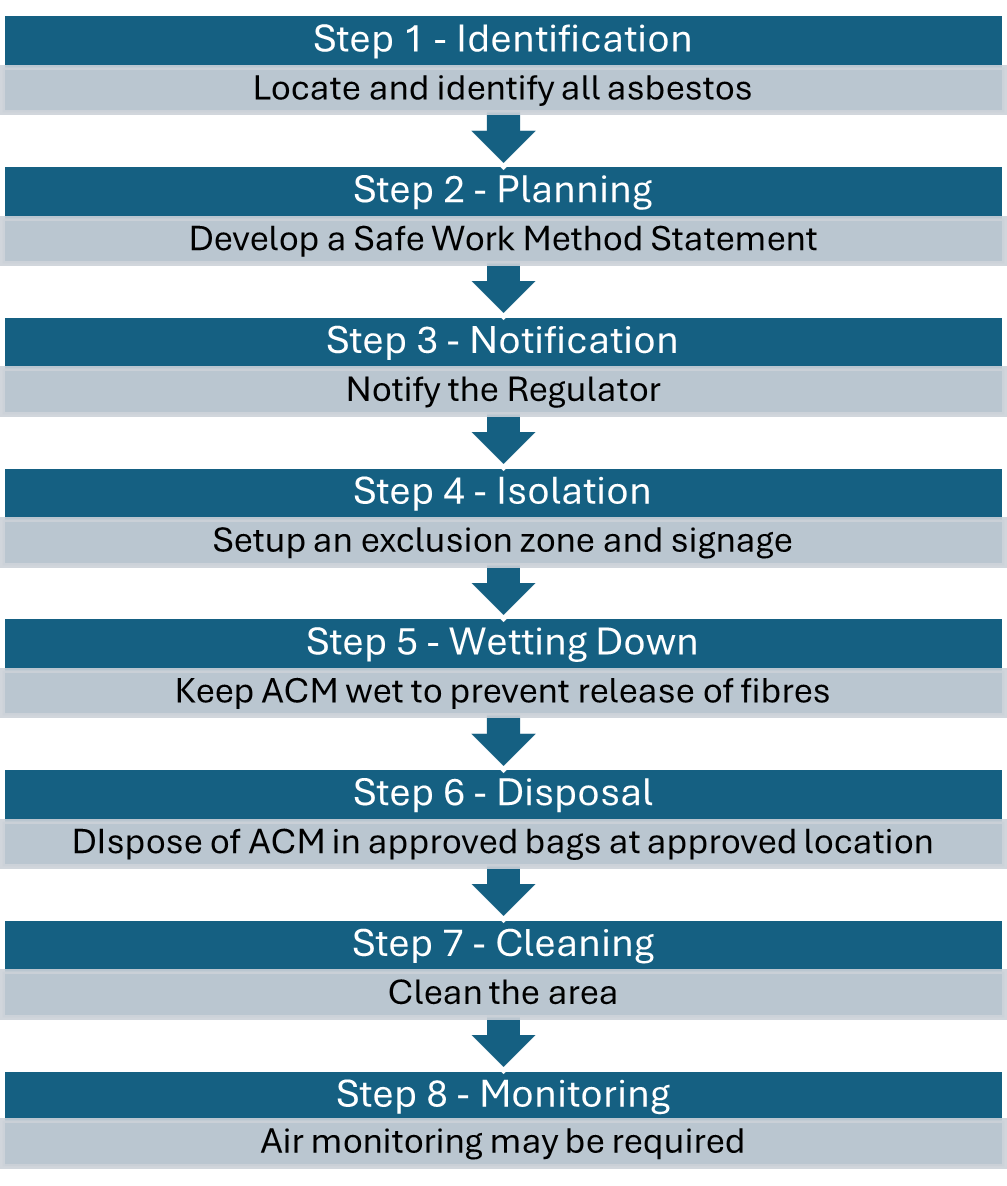Information on Asbestos Removal QLD
Information and Regulations on Asbestos Removal QLD

Regulatory requirements for Asbestos Removal in Queensland
Asbestos removal in QLD, Australia is governed by the Work Health and Safety Regulation 2011 (WHS Regulation). According to this regulation, the following requirements apply:
- Licensing: Individuals and businesses performing removal of asbestos must be licensed (either Class A or Class B) by Workplace Health and Safety Queensland (WHSQ).
- Training: All asbestos removal workers must be trained and competent in safe asbestos removal practices.
- Notification: Businesses and individuals must notify WHSQ at least 10 working days prior to starting asbestos removal in QLD if the amount of asbestos to be removed is more than 10 square meters or if the asbestos is friable.
- Safe Work Method Statement (SWMS): A Safe Work Method Statement must be prepared for all asbestos removal in QLD and outline the safe work procedures
- Air Monitoring: Air monitoring must be conducted during and after asbestos removal work to ensure that the concentration of airborne asbestos fibres is within safe limits.
- Disposal: Asbestos waste must be disposed of in accordance with the Environmental Protection Regulation 2008 and the Waste Reduction and Recycling Act 2011.
Asbestos Removal Licence Requirements
The below is an overview of requirements to apply for an asbestos removal license in QLD. To apply for a license for asbestos removal in QLD, Australia, you must meet the following requirements:
To apply for a license for asbestos removal in QLD, Australia, you must meet the following requirements:
- Training: Complete an approved asbestos removal training course.
- Insurance: Obtain public liability insurance with a minimum of $5 million coverage.
- Workplace Health and Safety (WHS) Management Plan: Develop a WHS Management Plan that outlines your policies and procedures for managing asbestos removal in QLD.
- Equipment: Ensure that you have all the necessary equipment, including personal protective equipment (PPE), for performing asbestos removal work safely.
- Experience: Provide evidence of at least 12 months of relevant industry experience.
- Application: Submit a complete and accurate license application to Workplace Health and Safety Queensland (WHSQ) along with the required fees.
- Assessment: Your application will be assessed by WHSQ, and they may conduct an inspection of your workplace to ensure compliance with the requirements while conducting asbestos removal in QLD.
How Do You Conduct Asbestos Removal and Demolition in QLD?
“How to Safely Remove Asbestos” is the asbestos code of practice in Queensland. This documents outlines the procedures, guidelines and legal requirements for asbestos removal in QLD. The key points in the code of practice are outlined below.

Identification
Locate and identify all asbestos materials prior to removal.
- Determine the age of the building: Asbestos was commonly used in building materials and domestic premises in Australia from the 1940s to the 1990s. If your building was constructed during this time, there is a higher chance that it contains ACM (asbestos containing material). Look for suspect materials: Some building materials that may contain asbestos products include ceiling tiles, insulation, roofing, guttering, flooring, wall cladding and cement.
- Check for asbestos labels or markings: Some building materials may be labeled or marked with information indicating that they contain asbestos.
- An independent competent person or laboratory test may be required.
- Do not disturb suspected asbestos: Do not disturb suspected asbestos or conduct demolition work as this may release dangerous asbestos fibers into the air (friable asbestos is particularly hazardous).
Planning
Plan the removal work and develop a Safe Work Method Statement (SWMS). SWMS should include:
- Identification of asbestos: Identify the type and location of the asbestos to be removed.
- Planning and preparation: Outline the steps that will be taken to plan and prepare for the removal work, including risk assessments, identification of potential hazards, and selection of appropriate personal protective equipment (PPE).
- Isolation and containment: Describe the methods that will be used to isolate and contain the area where the removal work will be carried out to prevent the spread of asbestos fibers.
- Wetting and handling of asbestos: Specify how the asbestos-containing materials will be kept wet during removal and how they will be handled to minimize the release of fibers.
- Removal of the asbestos waste: Detail the methods that will be used to safely transport and dispose of asbestos waste in accordance with the Environmental Protection Regulation 2008 and the Waste Reduction and Recycling Act 2011.
- Cleaning and decontamination: Explain the procedures that will be followed to clean and decontaminate the work area after removal to ensure that all asbestos fibers have been removed.
- Monitoring: Describe the air monitoring procedures that will be carried out during and after removal to ensure that the concentration of airborne asbestos fibres is within safe limits.
- Emergency procedures: Outline the emergency procedures that will be followed in the event of an accident or exposure to asbestos fibres.
- Training and competency: Identify the training and competency requirements for workers involved in the removal work, including the use of PPE and emergency procedures to ensure work is only completed by a competent person.
- Review and updates: Include a process for regularly reviewing and updating the SWMS to ensure that it remains current and relevant.
Notification
Notify the relevant authorities, such as Workplace Health and Safety Queensland (WHSQ), at least 10 working days prior to removal if the amount of asbestos to be removed is more than 10 square meters or if the asbestos is friable.
- Complete the Notification of Asbestos Removal form: You can obtain this form from the WHSQ website or by contacting the WHSQ asbestos management unit.
- Submit the form: Submit the completed form to the WHSQ asbestos management unit by email, fax, or post.
- Provide required information: The form requires information about the location and type of asbestos to be removed, the start and completion dates of the removal work, and the names of the licensed asbestos removalists who will be conducting the work.
- Payment of fees: The form may also require payment of a fee for the notification.
- It is important to submit the notification form to the WHSQ asbestos management unit as early as possible before the removal work is due to commence, to ensure that all regulatory requirements are met. Failure to notify WHSQ of asbestos removal in QLD can result in significant fines and legal consequences.
Personal Protective Equipment (PPE): Use appropriate PPE, including respiratory protection, to minimize exposure to asbestos fibres.
- For asbestos removal in Queensland, Australia, workers must wear personal protective equipment (PPE) to minimize the risk of exposure to asbestos fibres. The minimum PPE required for asbestos removal work includes:
- Respiratory protection: Workers must wear a suitable respirator or mask that is designed to filter asbestos fibres from the air they breathe. A half-face respirator with a P1 or P2 filter is typically required.
- Protective clothing: Workers must wear disposable coveralls, gloves, and boots that are designed to prevent asbestos fibers from coming into contact with their skin. The clothing must be disposed of after use and not taken home.
- Eye protection: Workers must wear safety glasses or goggles to protect their eyes from exposure to asbestos fibres.
- Hard hat: Workers must wear a hard hat to protect their head from falling debris.
- It is important to note that additional PPE may be required, depending on the nature and extent of the removal work. Workers must be trained in the use and care of PPE, and the PPE must be properly maintained and replaced when it becomes damaged or reaches the end of its usable life.
Isolation
Isolate the area where the removal work will be carried out to prevent the spread of asbestos fibres.
- Identification of the work area: Clearly identify the area where the asbestos removal work will be carried out.
- Physical barriers: Install physical barriers, such as polyethylene sheeting, around the work area to prevent the spread of asbestos fibers. The barriers should be securely attached to the walls, floors, and ceiling and sealed at all seams and joints.
- Access control: Limit access to the work area to authorized personnel only. Post warning signs and tape or barricades to prevent unauthorized entry.
Wetting
Keep asbestos-containing materials wet during removal to minimize the release of fibres.
- Use a water spray, mist, or damp cloth: Wet the asbestos-containing materials with a continuous water spray, mist, or damp cloth. The water should be applied generously to keep the materials wet at all times.
- Avoid excess water: Do not use so much water that it creates a pool on the floor or saturates the materials to the point where they become waterlogged and difficult to handle.
- Keep the water supply continuous: Maintain a continuous water supply to the area where the asbestos removal work is taking place to ensure that the materials remain wet at all times.
- Use a wetting agent: Consider using a wetting agent, such as a surfactant, to help keep the materials wet and reduce the amount of water required.
Disposal
Dispose of asbestos waste in accordance with regulatory requirements:
- Packaging: Place the asbestos waste in heavy-duty plastic bags or containers that are specifically designed for the disposal of asbestos waste. The bags or containers should be sealed and labeled clearly with the word “asbestos.”
- Transport: Transport the asbestos waste to a licensed asbestos disposal facility in a secure manner. The waste should be placed in the trunk or bed of a vehicle and covered with a tarp to prevent any fibers from escaping during transit.
- Disposal facility: Take the asbestos waste to a licensed asbestos disposal facility (generally local council). The landfill facility will properly dispose of the waste in accordance with all applicable regulations and standards.
- Record-keeping: Keep a record of the asbestos waste disposal, including the date, location, and quantity of waste disposed.
Cleaning
Clean the area after removal to ensure that all asbestos fibres have been removed.
- Cover all surfaces with plastic sheeting to prevent the spread of any remaining asbestos fibers.
- Wet clean all surfaces, including floors, walls, and ceilings, to prevent the release of any asbestos fibers into the air.
- Vacuum the area using a HEPA (High-Efficiency Particulate Air) filtered vacuum cleaner to remove any remaining dust and debris.
- Dispose of all cleaning materials, including the plastic sheeting and vacuum cleaner bags, in asbestos-safe disposal bags.
- A clearance inspection may be required prior to completion of works, with a clearance certificate issued.
Monitoring
Conduct air monitoring during and after removal to ensure that the concentration of airborne asbestos fibres is within safe limits.
- Set up the equipment in the designated monitoring area, following the manufacturer’s instructions.
- Allow the equipment to run for a minimum of two hours, or longer if recommended by the assessor.
- Collect the air samples using specialized filters or cassettes, and label them with the date, time, and location of the sample.
- Seal the samples in appropriate containers for transport and analysis.
- Send the samples to a laboratory for analysis, following the guidelines set by the National Association of Testing Authorities (NATA) or equivalent.
- Receive the laboratory results and review them to ensure that the levels of asbestos fibers in the air are below the safe limit.
- Provide a written report of the air monitoring results to the relevant parties, including the property owner and any relevant government agencies.
FAQs
What is asbestos?
Asbestos is a group of naturally occurring minerals used in building materials for insulation and fire resistance. It is hazardous when its fibers become airborne and inhaled.
Why is asbestos removal important?
Asbestos removal is crucial because inhaling asbestos fibers can cause serious health issues, including lung cancer and asbestosis. Safe removal prevents exposure and protects public health.
Who should perform asbestos removal?
Only licensed professionals should perform asbestos removal. They have the necessary training and equipment to handle asbestos safely.
What precautions should be taken during asbestos removal?
Precautions include sealing off the area, using protective gear, and employing proper disposal methods. These steps minimize the risk of asbestos fiber release.
How can I identify asbestos in my home?
Asbestos identification requires a professional inspection. Do not disturb suspected materials, as this can release harmful fibers.
Is it safe to stay in my home during asbestos removal?
It is generally recommended to vacate the premises during asbestos removal. This ensures you are not exposed to any airborne fibers.
What should I do if I suspect asbestos in my home?
Contact a licensed asbestos inspector for an assessment. Avoid disturbing the material until it has been professionally evaluated.
How is asbestos disposed of?
Asbestos waste must be sealed in leak-proof containers and disposed of at designated facilities. This prevents environmental contamination and health risks.
Further Information for Asbestos Removal and Disposal in QLD
For help with licencing for asbestos removal in QLD, safety management systems or other safety issues, contact us.
For further information, read the Queensland Government Code of Practice or visit https://www.asbestos.qld.gov.au.

